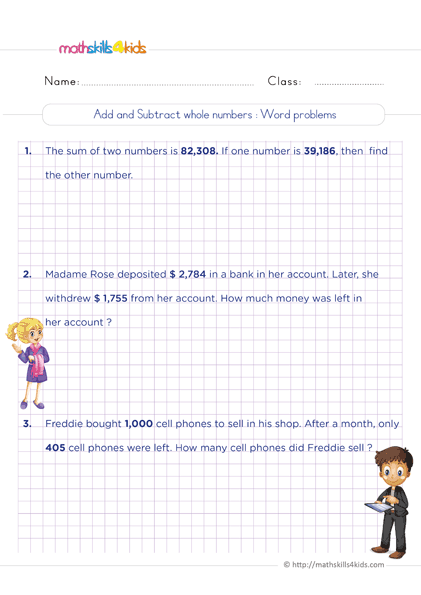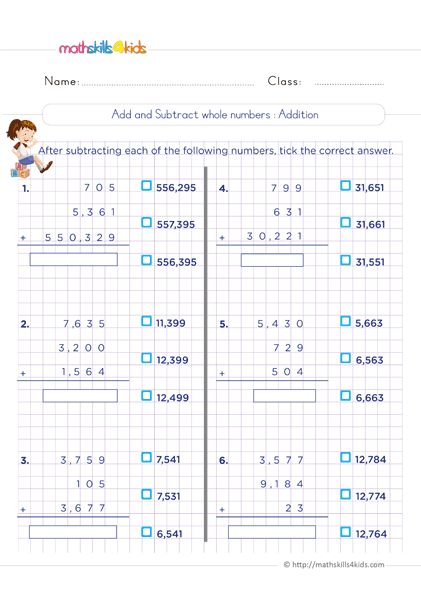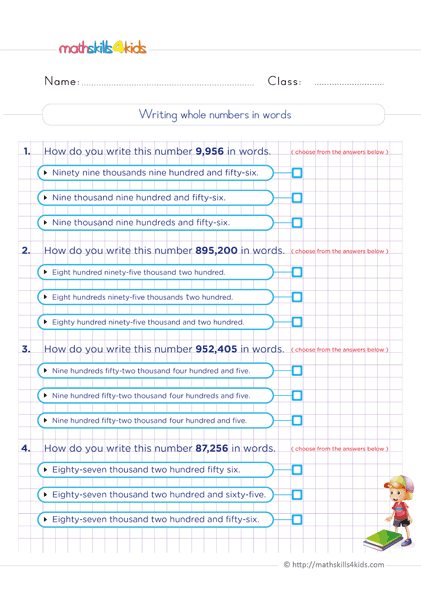Addition and Subtraction of Whole Numbers Word Problems Worksheets for Grade 6
Are your kids ready to practice their addition and subtraction skills with fun and challenging word problems? If they are, then you will love these addition and subtraction of whole numbers word problems worksheets for grade 6!
They must use their logical thinking and problem-solving skills to find the answers. Some word problems are easy, but some are tricky and require multiple steps. Don't worry; you can do it! Just remember to check your answers.
These addition and subtraction of whole numbers word problems worksheets for grade 6 will help your kids master these math skills and prepare them for more advanced math topics.
-
GRADE 6 MATH TOPICS
- Whole numbers
- Multiplication
- Division
- Exponents and square roots
- Number theory
- Decimals
- Add & subtract decimals
- Multiply & divide decimals
- Fractions & mixed numbers
- Add & subtract fractions
- Multiply fractions
- Divide fractions
- Integers
- Operations with integers
- Mixed operations
- Rational numbers
- Problems solving
- Ratio & proportions
- Percentages
- Measuring units
- Money math
- Consumer math
- Telling time
- Coordinate graph
- Algebraic expressions
- One step equations
- Solve & graph inequalities
- Two-step equations
- 2D Geometry
- Symmetry & transformation
- 3D Shapes
- Geometry measurement
- Data and Graphs
- Statistics
- Probability
-
Grade 6 add & subtract whole numbers word problems worksheets
Click to download the worksheets:
More of 6th Grade whole numbers worksheets pdf
-

Add and Subtract Whole Numbers Word Problems for Grade 6 with solutions and explanations
-
Here are 10 multiple-choice questions (MCQs) with four options each. Students can check their answers at the end of each worksheet.
- A library has 22,740 books in its collection. It lends out 5,219 books and receives 937 books as donations. How many books are left in the library after these transactions?
- A bakery sells 7,345 loaves of bread, 1,090 cupcakes, and 5,456 other pastries in a month. How many pastries did the bakery sell in all during the month?
- A factory produces 8,765 widgets in a week. It sells 6,543 widgets and discards 234 widgets as defective. How many widgets are left in the factory at the end of the week?
- A farmer has 123 cows and 456 sheep. He sells 78 cows and buys 45 sheep. How many cows and sheep does he have now?
- A store has 789 bottles of juice and 456 cans of soda. It sells 345 bottles of juice and 234 cans of soda in a day. How many bottles of juice and cans of soda are left in the store after a day?
- A family has a budget of $2,345 for a vacation. They spend $1,234 on transportation, $567 on accommodation, and $234 on food. How much money do they have left for other expenses?
- A museum receives 12,345 visitors per month. 3,987 of the visitors were adults, 5,067 were children over the age of 12, and the rest of the visitors were children under the age of 12. How many children under 12 visited the museum during the month?
- A box contains 123 chocolates of different flavors. There are 45 chocolates with caramel filling, 34 chocolates with nuts, and the rest are plain chocolates. How many plain chocolates are there in the box?
- A school bus can carry 56 students at a time. It makes three trips to pick up students from different locations and bring them to school. How many students can the bus pick up in total? How many students are left if there are 345 students who need to go to school?
- A company has a revenue of $12,345 in a month. It spends $5,678 on salaries, $2,345 on rent, $1,234 on utilities, and $567 on other expenses. How much profit or loss does the company make in a month?
Addition and subtraction of whole numbers word problems answers:
To find the number of books left in the library, we need to subtract the number of books lent out and add the number of books donated to the original collection.
The equation is 22,740 - 5,219 + 937 = 18,458.
Therefore, there are 18,458 books left in the library after these transactions.
To find the number of pastries sold by the bakery in a month, we need to add the number of loaves of bread, cupcakes, and other pastries.
The equation is 7,345 + 1,090 + 5,456 = 13,891.
Therefore, the bakery sold 13,891 pastries in all during the month.
To find the number of widgets left in the factory at the end of the week, we need to subtract the number of widgets sold and discarded from the number of widgets produced.
The equation is 8,765 - 6,543 - 234 = 1,988.
Therefore, there are 1,988 widgets left in the factory at the end of the week.
-
To find the number of cows and sheep that the farmer has now, we need to subtract the number of cows sold and add the number of sheep bought to the original numbers.
The equations are 123 - 78 = 45 and 456 + 45 = 501.
Therefore, the farmer has 45 cows and 501 sheep now.
To find the number of bottles of juice and cans of soda left in the store after a day, we need to subtract the number of bottles of juice and cans of soda sold from the original numbers.
The equations are 789 - 345 = 444 and 456 - 234 = 222.
Therefore, there are 444 bottles of juice and 222 cans of soda left in the store after a day.
To find out how much money the family has left for other expenses, we need to subtract the total amount they spend from their budget.
The total amount they spend is $1,234 + $567 + $234 = $2,035.
The amount they have left is $2,345 - $2,035 = $310. Therefore, the family has $310 left for other expenses.
To find out how many children under 12 visited the museum during the month, we need to subtract the number of adults and children over 12 from the total number of visitors.
The number of adults and children over 12 is 3,987 + 5,067 = 9,054.
The number of children under 12 is 12,345 - 9,054 = 3,291. Therefore, 3,291 children under 12 visited the museum during the month.
To find out how many plain chocolates are there in the box, we need to subtract the number of chocolates with caramel filling and nuts from the total number of chocolates.
The number of chocolates with caramel filling and nuts is 45 + 34 = 79.
The number of plain chocolates is 123 - 79 = 44.
Therefore, there are 44 plain chocolates in the box.
To find out how many students the bus can pick up in total, we need to multiply the number of students it can carry at a time by the number of trips it makes.
The number of students it can pick up in total is 56 + 56 + 56 = 168.
To find out how many students are left, we need to subtract the number of students it can pick up from the number of students who need to go to school.
The number of students who are left is 345 - 168 = 177.
Therefore, the bus can pick up 168 students in total, and there are 177 students left.
To find out how much profit or loss the company makes in a month, we need to subtract the total expenses from the revenue.
The total expenses are $5,678 + $2,345 + $1,234 + $567 = $9,824.
The profit or loss is $12,345 - $9,824 = $2,521.
Therefore, the company makes a profit of $2,521 in a month.



